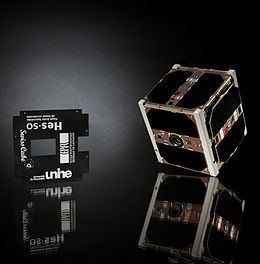Mission type AtmosphericTechnology COSPAR ID 2009-051B Website swisscube.epfl.ch Inclination 98.39° Period 1.6 hours Launch mass 1,000 g | Operator EPFL SATCAT no. 35932 Launch date 23 September 2009 Inclination 98.39° Launch mass 1,000 g | |
 | ||
Mission duration 3-12 months planned84+ months achieved Similar BeeSat‑1, ITUpSAT1, UWE‑2, PharmaSat, AeroCube 3 | ||
SwissCube-1 is a Swiss satellite operated by Ecole Polytechnique Fédérale de Lausanne (EPFL). The spacecraft is a single unit CubeSat, which was designed to conduct research into nightglow within the Earth's atmosphere, and to develop technology for future spacecraft. It has also been used for amateur radio. It was the first Swiss satellite to be launched.
History
SwissCube-1 was launched by the Indian Space Research Organisation aboard the Polar Satellite Launch Vehicle, serial number C14, flying in the Core Alone, or PSLV-CA, configuration. The launch took place from the First Launch Pad at the Satish Dhawan Space Centre, at 06:21 UTC on 23 September 2009. SwissCube-1 was a secondary payload aboard the rocket, which deployed the Oceansat-2 satellite. Five other secondary payloads were flown aboard the rocket; BeeSat, UWE-2, ITU-pSat1, Rubin 9.1 and Rubin 9.2.
SwissCube-1 is operating in a sun synchronous orbit with an apogee of 752 kilometres (467 mi), a perigee of 726 kilometres (451 mi) and 98.28 degrees of inclination to the equator. It has an orbital period of 98.5 minutes.
Its mission was expected to last between three and twelve months. The mission was extended an additional 18 months in February 2010 and an additional ground command facility was added. It took its first picture on 18 February 2011 and its first airglow picture on 3 March 2011.
On 2 December 2011, EPFL ended the SwissCube project and turned over control of the satellite to amateur radio operators. As of November 2016 SwissCube is still operational after seven years in space.
In anticipation of its future "debris" status in light of the slowly degrading lithium-ion batteries, the Clean Space One project was launched in 2012 to provide a spacecraft able to catch SwissCube-1 and remove it from orbit in the 2020 horizon.
